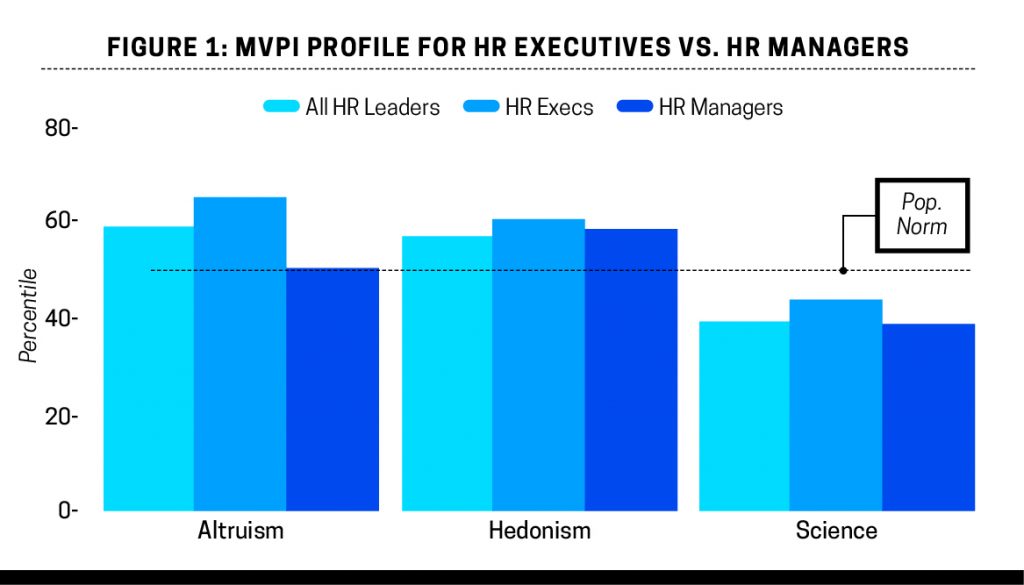We looked at the personalities of more than 1,000 HR executives to see how they stack up against other workers around the world. Here’s what we found.
By Ryne A. Sherman, Ph.D., and Matthew R. Lemming
The primary task of human resources has historically been to handle employee benefits and grievances. As such, HR played a very minimal role in corporate strategy and an organization’s success or failure. This might have worked just fine when the people working in steel mills and on factory floors were viewed as replaceable cogs in a machine. Not so much anymore.
Modern organizations now realize the critical role that talent (i.e., the people in the organization) plays in its success. That is, people aren’t just replaceable cogs in a machine; some employees are better than others, and employing top talent is a major factor in organizational success.
Sign up for the monthly TalentQ Newsletter, an essential roundup of news and insights that will help you make critical talent decisions.
This change is reflected in the rise of people analytics, strategic HR, and new job titles like chief people officer. As a result, HR has taken a more prominent role in modern organizations. The unit is now tasked with building a sustainable competitive advantage through the management and acquisition of top talent.
We can consider the HR unit of any organization to be itself a sort of mini-organization. Thus, the same principles that apply to the larger organization apply to HR as well. We know that the success or failure of any organization largely depends on the leader. Therefore, it makes sense to examine the personalities of those people who are leading HR departments around the globe.
To do so, we searched our archives for every person who had completed a Hogan Assessment with one of the following job titles: chief HR officer (CHRO), chief people officer (CPO), executive/senior vice president of HR (EVPs/SVPs), vice president/associate vice president of HR (VPs/AVPs), director/head of HR, and HR manager.
We identified more than 1,000 HR leaders in these roles. We analyzed the personalities of these HR leaders, comparing them with our global normative data.
How do HR leaders differ from other members of the global working population? In what follows, we describe our findings in terms of differences in motivation, everyday bright-side behaviors, and dark-side behaviors that occur when we let our guard down.
Human Resources Versus Everyone Else
In terms of motivation, we find that HR leaders are above average on Altruism (defined as a concern about the welfare of others and the desire to contribute to a better society) and above average on Hedonism (a desire to enjoy life and have fun).
Additionally, HR leaders scored well below average on Science (a desire for knowledge and using data to drive decision-making). This means the typical HR leader wants to help others, enjoys fun work environments, and prefers making decisions based on experience and gut feelings as opposed to data or scientific research.
Figure 1: MVPI Profile for HR Executives v. HR Managers

In terms of their typical daily behavior, we discovered that HR leaders are above average on Ambition (the tendency to take the lead, compete with others, and push for results), above average on Interpersonal Sensitivity (the tendency to be caring, get along with others, and avoid conflict), and below average on Inquisitiveness (the tendency to be curious, inquisitive, and open to new ideas).
This means the typical HR leader comes across to others as warm, friendly, and caring; competitive and leader-like; and grounded and practical.
Figure 2. HPI Profile for HR Executives v. HR Managers

In terms of dark-side behaviors, or the way HR leaders derail and hurt their own careers, we discovered a distinction between HR executives and HR managers. Specifically, HR executives score above average on moving against(the tendency to directly engage in confrontation and “win” interpersonal conflicts through force of will) behaviors.
Figure 3. HDS Profile for HR Executives v. HR Managers

Lower-level HR managers, on the other hand, scored above average on moving away(the tendency to avoid confrontations and interpersonal conflict) behaviors and above average on moving toward(the tendency to resolve confrontation and interpersonal problems by befriending and working hard to please the source of the conflict) behaviors.
Thus, HR leaders in higher-level roles are more likely to confront problems directly through intimidation or charm, whereas those in lower-level leadership roles are more likely to avoid direct confrontation.
Overall, these results paint a portrait of the typical HR leader as someone who cares deeply about other people, wants other people to enjoy work, resists anything construed as an unfair workplace demand, and uses intuition and experience to solve workplace problems.
The Upshot: What Does This All Mean?
Successful organizations must make good decisions about money and people. Though organizations have always recognized the importance of being smart about money, they’ve only recently begun to realize the critical role that talent plays in success.
A key insight from this study is that the typical HR leader isn’t particularly persuaded by data-based arguments and data-based decision-making, and not well-versed in scientifically literacy. As a result, the average HR leader isn’t capable of distinguishing truly valid assessments—those that actually predict job performance—from invalid ones.

This presents a challenge for legitimate providers who use scientifically validated assessments. Arguments centered around data, validity, and return on investment may not work with key HR decision-makers because they value personal experience more and are unable to critically evaluate the scientific merits of various assessments.
This finding may, in part, explain the recent influx of unscrupulous assessment providers, who largely emphasize marketing and user experience (at the expense of predicting performance), into organizations.
For legitimate assessment providers, we see four ways forward:
1. Assessment providers ought to work more closely with HR educators to emphasize the importance of making personnel decisions based on scientifically-proven selection methods.
2. Organizations should be able to improve their own personnel selection processes by simply hiring and promoting HR professionals with scientific backgrounds to more senior roles.
3. Assessment providers will need to continue educating their clients on the critical importance of assessment validity.
4. Assessment providers would be wise to adapt their marketing and platforms—without sacrificing validity—to meet the expectations of clients who may be less scientifically savvy and more interested in style, design, and user experience.
Ryne A. Sherman, Ph.D., is the chief science officer of Hogan Assessments. Prior to joining Hogan, he was an associate professor in the department of psychology at Texas Tech University, where he researched the importance of individual differences, the psychological properties of situations, and developing tools for data analysis.
Matthew R. Lemming is a senior research consultant at Hogan Assessments. Prior to joining Hogan, he was a strategic data manager at Purdue University, where he analyzed data that guided decision making and monitored progress toward strategic goals.


